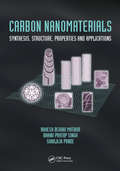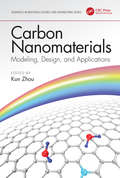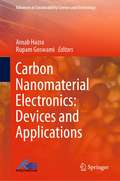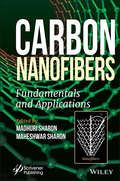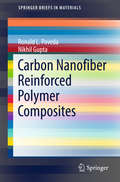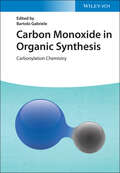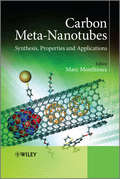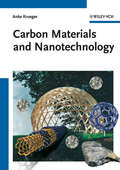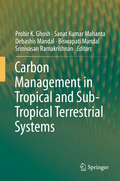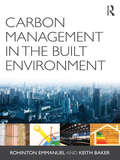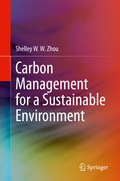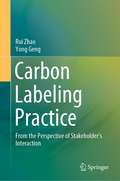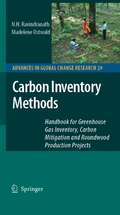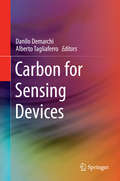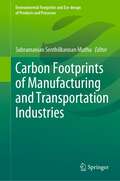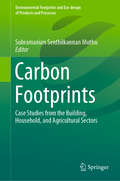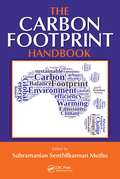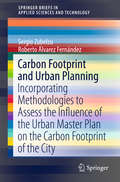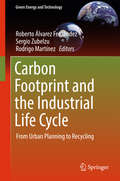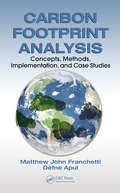- Table View
- List View
Carbon Nanomaterials: Synthesis, Structure, Properties and Applications
by Rakesh Behari Mathur Bhanu Pratap Singh Shailaja PandeThe study of nanostructures has become, in recent years, a theme common to many disciplines, in which scientists and engineers manipulate matter at the atomic and molecular level in order to obtain materials and systems with significantly improved properties. Carbon nanomaterials have a unique place in nanoscience owing to their exceptional thermal, electrical, chemical, and mechanical properties, finding application in areas as diverse as super strong composite materials, energy storage and conversion, supercapacitors, smart sensors, targeted drug delivery, paints, and nanoelectronics. This book is the first to cover a broad spectrum of carbon nanomaterials, namely carbon nanofibers, vapor-grown carbon fibers, different forms of amorphous nanocarbons besides carbon nanotubes, fullerenes, graphene, graphene nanoribbons, graphene quantum dots, etc. in a single volume.
Carbon Nanomaterials: Synthesis, Structure, Properties and Applications
by Rakesh Behari Mathur Bhanu Pratap Singh Shailaja PandeThe study of nanostructures has become, in recent years, a theme common to many disciplines, in which scientists and engineers manipulate matter at the atomic and molecular level in order to obtain materials and systems with significantly improved properties. Carbon nanomaterials have a unique place in nanoscience owing to their exceptional thermal, electrical, chemical, and mechanical properties, finding application in areas as diverse as super strong composite materials, energy storage and conversion, supercapacitors, smart sensors, targeted drug delivery, paints, and nanoelectronics. This book is the first to cover a broad spectrum of carbon nanomaterials, namely carbon nanofibers, vapor-grown carbon fibers, different forms of amorphous nanocarbons besides carbon nanotubes, fullerenes, graphene, graphene nanoribbons, graphene quantum dots, etc. in a single volume.
Carbon Nanomaterials: Modeling Design And Applications (Advances in Materials Science and Engineering)
by Kun ZhouCarbon Nanomaterials: Modeling, Design, and Applications provides an in-depth review and analysis of the most popular carbon nanomaterials, including fullerenes, carbon nanotubes, graphene and novel carbon nanomaterial-based membranes and thin films, with emphasis on their modeling, design and applications. This book provides basic knowledge of the structures, properties and applications of carbon-based nanomaterials. It illustrates the fundamental structure-property relationships of the materials in both experimental and modeling aspects, offers technical guidance in computational simulation of nanomaterials, and delivers an extensive view on current achievements in research and practice, while presenting new possibilities in the design and usage of carbon nanomaterials. This book is aimed at both undergraduate and graduate students, researchers, designers, professors, and professionals within the fields of materials science and engineering, mechanical engineering, applied physics, and chemical engineering.
Carbon Nanomaterial Electronics: Devices and Applications (Advances in Sustainability Science and Technology)
by Arnab Hazra Rupam GoswamiThis book brings together selective and specific chapters on nanoscale carbon and applications, thus making it unique due to its thematic content. It provides access to the contemporary developments in carbon nanomaterial research in electronic applications. Written by professionals with thorough expertise in similar broad area, the book is intended to address multiple aspects of carbon research in a single compiled edition. It targets professors, scientists and researchers belonging to the areas of physics, chemistry, engineering, biology and medicine, and working on theory, experiment and applications of carbon nanomaterials.
Carbon Nanofibers: Fundamentals and Applications (Advances in Nanotechnology and Applications)
by Madhuri Sharon Maheshwar SharonThis book covers the fundamentals and applications of Carbon Nanofiber (CNF). In the first section, the initial chapter on the fundamentals of CNF is by Professor Maheshwar Sharon, the recognized “Father of Carbon Nanotechnology in India”, which powerfully provides a succinct overview of CNFs. This is followed by a chapter on biogenics that have produced unique morphologies of CNF that makes them suitable to various applications. This is followed by a chapter that mainly focuses on nanocomposites, especially those involving nanocomposites of CNF. The role of nanocatalysts and composites in promoting and enhancing the synthesis and application of CNF is then covered, followed by an important chapter on the characterization of CNF. The second section of the book encompasses the various applications of CNF, such as its use as a possible superconductor to adsorb and store hydrogen, and as a microwave absorber. The application of CNF for environmental concerns is also detailed by assessing its usefulness in dye and heavy metal removal from polluted water. The applications that are addressed include lithium-ion battery, solar cell, antenna, cosmetics, usefulness in regenerative medicine, as well as various aspects of agrotechnology.
Carbon Nanofibers: Fundamentals and Applications (Advances in Nanotechnology and Applications)
by Madhuri Sharon Maheshwar SharonThis book covers the fundamentals and applications of Carbon Nanofiber (CNF). In the first section, the initial chapter on the fundamentals of CNF is by Professor Maheshwar Sharon, the recognized “Father of Carbon Nanotechnology in India”, which powerfully provides a succinct overview of CNFs. This is followed by a chapter on biogenics that have produced unique morphologies of CNF that makes them suitable to various applications. This is followed by a chapter that mainly focuses on nanocomposites, especially those involving nanocomposites of CNF. The role of nanocatalysts and composites in promoting and enhancing the synthesis and application of CNF is then covered, followed by an important chapter on the characterization of CNF. The second section of the book encompasses the various applications of CNF, such as its use as a possible superconductor to adsorb and store hydrogen, and as a microwave absorber. The application of CNF for environmental concerns is also detailed by assessing its usefulness in dye and heavy metal removal from polluted water. The applications that are addressed include lithium-ion battery, solar cell, antenna, cosmetics, usefulness in regenerative medicine, as well as various aspects of agrotechnology.
Carbon Nanofiber Reinforced Polymer Composites (SpringerBriefs in Materials)
by Ronald L. Poveda Nikhil GuptaThis book presents an extensive review of literature on the properties of carbon nanofibers (CNF) reinforced polymer composites in conjunction with advances in the production and properties of CNFs. It further provides readers a view into the development of lightweight composites whose properties are tailored and enhanced with micro- and nano-reinforcement, along with results from data comparisons from several published investigations.
Carbon Monoxide in Organic Synthesis: Carbonylation Chemistry
by Bartolo GabrieleA thoroughly up-to-date overview of carbonylation reactions in the presence of carbon monoxide In Carbon Monoxide in Organic Synthesis: Carbonylation Chemistry, expert researcher and chemist Bartolo Gabriele delivers a robust summary of the most central advances in the field of carbonylation reactions in the presence of carbon monoxide. Beginning with a brief introduction on the importance of carbon monoxide as a building block in modern organic synthesis, the author goes on to describe metal-catalyzed carbonylations utilizing iron, cobalt, nickel, copper, and manganese. Descriptions of palladium, ruthenium, and rhodium-catalyzed reactions follow, as do discussions of metal-free carbonylation processes. The book is organized by metal to make the book useful as a guide for researchers from both academia and industry whose work touches on the direct synthesis of carbonyl compounds, carboxylic acid derivatives, and heterocycles. It aims to stimulate further discoveries in this rapidly developing field. Readers will also enjoy: A thorough introduction to carbonylations promoted by first row transition metal catalysts, including cobalt-catalyzed and nickel-catalyzed carbonylations An exploration of carbonylations promoted by second row transition metal catalysts, including ruthenium-, rhodium-, palladium(0)-, and palladium(II)-catalyzed carbonylations Practical discussions of miscellaneous carbonylation reactions, including carbonylations promoted by third row transition metal catalysts and metal-free carbonylation processes Perfect for catalytic and organic chemists, Carbon Monoxide in Organic Synthesis: Carbonylation Chemistry is also an indispensable resource for chemists working with organometallics and industrial chemists seeking a summary of important processes used to synthesize value-added products.
Carbon Monoxide in Organic Synthesis: Carbonylation Chemistry
by Bartolo GabrieleA thoroughly up-to-date overview of carbonylation reactions in the presence of carbon monoxide In Carbon Monoxide in Organic Synthesis: Carbonylation Chemistry, expert researcher and chemist Bartolo Gabriele delivers a robust summary of the most central advances in the field of carbonylation reactions in the presence of carbon monoxide. Beginning with a brief introduction on the importance of carbon monoxide as a building block in modern organic synthesis, the author goes on to describe metal-catalyzed carbonylations utilizing iron, cobalt, nickel, copper, and manganese. Descriptions of palladium, ruthenium, and rhodium-catalyzed reactions follow, as do discussions of metal-free carbonylation processes. The book is organized by metal to make the book useful as a guide for researchers from both academia and industry whose work touches on the direct synthesis of carbonyl compounds, carboxylic acid derivatives, and heterocycles. It aims to stimulate further discoveries in this rapidly developing field. Readers will also enjoy: A thorough introduction to carbonylations promoted by first row transition metal catalysts, including cobalt-catalyzed and nickel-catalyzed carbonylations An exploration of carbonylations promoted by second row transition metal catalysts, including ruthenium-, rhodium-, palladium(0)-, and palladium(II)-catalyzed carbonylations Practical discussions of miscellaneous carbonylation reactions, including carbonylations promoted by third row transition metal catalysts and metal-free carbonylation processes Perfect for catalytic and organic chemists, Carbon Monoxide in Organic Synthesis: Carbonylation Chemistry is also an indispensable resource for chemists working with organometallics and industrial chemists seeking a summary of important processes used to synthesize value-added products.
Carbon Meta-Nanotubes: Synthesis, Properties and Applications
by Marc MonthiouxMeta-Nanotubes are a new generation of carbon nanotubes (CNTs) which result from the chemical transformation of regular CNTs and their subsequent combination with foreign materials (atoms, molecules, chemical groups, nanocrystals) by various ways such as functionalisation, doping, filling, and substitution. These new nanomaterials exhibit enhanced or new properties, such as reactivity, solubility, and magnetism, which pristine CNTs do not possess. Their many applications include electronic and optoelectronic devices, chemical and biosensors, solar cells, drug delivery, and reinforced glasses and ceramics. Carbon Meta-Nanotubes: Synthesis, Properties and Applications discusses these third generation carbon nanotubes and the unique characteristics they possess. Beginning with a general overview of the subject, this book covers the five main categories of meta-nanotubes, namely: Doped Carbon Nanotubes Functionalised Carbon Nanotubes Decorated or Coated Carbon Nanotubes Filled Carbon Nanotubes Heterogeneous Nanotubes Providing unparalleled coverage of these third generation or meta-nanotubes, and possibilities for future development, this book is essential for anyone working on carbon nanotubes.
Carbon Meta-Nanotubes: Synthesis, Properties and Applications
by Marc MonthiouxMeta-Nanotubes are a new generation of carbon nanotubes (CNTs) which result from the chemical transformation of regular CNTs and their subsequent combination with foreign materials (atoms, molecules, chemical groups, nanocrystals) by various ways such as functionalisation, doping, filling, and substitution. These new nanomaterials exhibit enhanced or new properties, such as reactivity, solubility, and magnetism, which pristine CNTs do not possess. Their many applications include electronic and optoelectronic devices, chemical and biosensors, solar cells, drug delivery, and reinforced glasses and ceramics. Carbon Meta-Nanotubes: Synthesis, Properties and Applications discusses these third generation carbon nanotubes and the unique characteristics they possess. Beginning with a general overview of the subject, this book covers the five main categories of meta-nanotubes, namely: Doped Carbon Nanotubes Functionalised Carbon Nanotubes Decorated or Coated Carbon Nanotubes Filled Carbon Nanotubes Heterogeneous Nanotubes Providing unparalleled coverage of these third generation or meta-nanotubes, and possibilities for future development, this book is essential for anyone working on carbon nanotubes.
Carbon Materials and Nanotechnology
by Anke KrügerThe first textbook to cover this exciting compound class, this introduction to the field of carbon nanotechnology discusses everything from nanowires to nanodiamonds, and from synthesis to applications. From the contents: * Carbon * Fullerenes * Carbon nanotubes * Carbon onions and related structures * Nanodiamonds * Diamond films Of interest not only for students but for all material scientists as well as organic and inorganic chemists, or anyone in need of a quick overview of the field.
Carbon Management in Tropical and Sub-Tropical Terrestrial Systems
by Probir K. Ghosh Sanat Kumar Mahanta Debashis Mandal Biswapati Mandal Srinivasan RamakrishnanSoil organic carbon (SOC), a key component of the global carbon (C) pool, plays an important role in C cycling, regulating climate, water supplies and biodiversity, and therefore in providing the ecosystem services that are essential to human well-being. Most agricultural soils in temperate regions have now lost as much as 60% of their SOC, and as much as 75% in tropical regions, due to conversion from natural ecosystems to agricultural uses and mainly due to continuous soil degradation. Sequestering C can help to offset C emissions from fossil fuel combustion and other C-emitting activities, while also enhancing soil quality and long-term agronomic productivity. However, developing effective policies for creating terrestrial C sinks is a serious challenge in tropical and subtropical soils, due to the high average annual temperatures in these regions. It can be accomplished by implementing improved land management practices that add substantial amounts of biomass to soil, cause minimal soil disturbance, conserve soil and water, improve soil structure, and enhance soil fauna activity. Continuous no-till crop production is arguably the best example. These soils need technically sound and economically feasible strategies to sustainably enhance their SOC pools. Hence, this book provides comprehensive information on SOC and its management in different land-use systems, with a focus on preserving soils and their ecosystem services. The only book of its kind, it offers a valuable asset for students, researchers, policymakers and other stakeholders involved in the sustainable development and management of natural resources at the global level.
Carbon Management in the Built Environment
by Rohinton Emmanuel Keith BakerThree broad sectors of the economy are generally recognized as key to a low carbon future: energy, construction and transportation. Of these, carbon management in the built environment remains the least well-studied. This much-needed book brings together the latest developments in the field of climate change science, building design, materials science, energy and policy in a form readily accessible to both students of the built environment and practitioners. Although several books exist in the broad area of carbon management, this is the first to bring together carbon management technology, technique and policy as they apply to the building sector. Clear and succinct sections on the overarching principles, policies, approaches and technologies are combined with case studies and more in-depth coverage of the most relevant topics. It explains how to produce a simple carbon footprint calculation, while also being an informative guide for those developing or implementing more advanced approaches. This easy to read book is the ideal primer for anyone needing to get to grips with carbon management in the built environment.
Carbon Management in the Built Environment
by Rohinton Emmanuel Keith BakerThree broad sectors of the economy are generally recognized as key to a low carbon future: energy, construction and transportation. Of these, carbon management in the built environment remains the least well-studied. This much-needed book brings together the latest developments in the field of climate change science, building design, materials science, energy and policy in a form readily accessible to both students of the built environment and practitioners. Although several books exist in the broad area of carbon management, this is the first to bring together carbon management technology, technique and policy as they apply to the building sector. Clear and succinct sections on the overarching principles, policies, approaches and technologies are combined with case studies and more in-depth coverage of the most relevant topics. It explains how to produce a simple carbon footprint calculation, while also being an informative guide for those developing or implementing more advanced approaches. This easy to read book is the ideal primer for anyone needing to get to grips with carbon management in the built environment.
Carbon Management for a Sustainable Environment
by Shelley W. ZhouThis textbook presents students with a systematic approach for the quantification and management of greenhouse gas emissions (GHG) and provides best practices for optimal carbon management and quantification. The book begins with an overview of climate change basics and goes on to discuss carbon footprint measurements, carbon management concepts, and concludes by presenting carbon reduction solutions with applications for green buildings, smart transportation, waste management, and carbon trading and offsetting. The author provides practical examples and carbon management models that support innovative reduction solutions and presents a roadmap for the implementation and development of carbon management strategies, making it a useful resource for both upper undergraduate and graduate students as well as practitioners seeking a comprehensive framework to conduct carbon management.
Carbon Labeling Practice: From the Perspective of Stakeholder’s Interaction
by Rui Zhao Yong GengThis book focuses on the behavioral interactions among possible stakeholders in carbon labeling practice, brings the attentions of stakeholders’ interests to explore the opportunities, and challenges related to carbon labeling practice, thus to provide insight into low-carbon consumption and production. It is essential reading for students, researchers, and policy makers as well as those with a wider interest in environmental science and sustainable development.
Carbon Inventory Methods: Handbook for Greenhouse Gas Inventory, Carbon Mitigation and Roundwood Production Projects (Advances in Global Change Research #29)
by N.H. Ravindranath Madelene OstwaldCarbon Inventory Methods Handbook fills the need for a handbook that provides guidelines and methods required for carbon inventory. It provides detailed step-by-step information on sampling procedures, field and laboratory measurements, application of remote sensing and GIS techniques, modeling, and calculation procedures along with sources of data for carbon inventory. The book is driven by a growing need for ‘carbon inventory’ for land use sections such as forests.
Carbon for Sensing Devices
by Danilo Demarchi Alberto TagliaferroThis book reveals why carbon is playing such an increasingly prominent role as a sensing material. The various steps that transform a raw material in a sensing device are thoroughly presented and critically discussed. The authors deal with all aspects of carbon-based sensors, starting from the various hybridization and allotropes of carbon, with specific focus on micro and nano sized carbons (e.g., carbon nanotubes, graphene) and their growth processes. The discussion then moves to the role of functionalization and the different routes to achieve it. Finally, a number of sensing applications in various fields are presented, highlighting the connection with the basic properties of the various carbon allotropes. Readers will benefit from this book’s bottom-up approach, which starts from the local bonding in carbon solids and ends with sensing applications, linking the local hybridization of carbon atoms and its modification by functionalization to specific device performance. This book is a must-have in the library of any scientist involved in carbon based sensing application.
Carbon Footprints of Manufacturing and Transportation Industries (Environmental Footprints and Eco-design of Products and Processes)
by Subramanian Senthilkannan MuthuThis book presents carbon footprint calculation and mitigation in the manufacturing and transportation sectors. Warning effects of global warming from every sector is of phenomenal importance at this moment and sector wise assessment and remediation are the key factors to mitigate the vulnerable green house gas emissions. This volume with its six chapters deals with the carbon footprint of manufacturing and transportation sectors.
Carbon Footprints: Case Studies from the Building, Household, and Agricultural Sectors (Environmental Footprints and Eco-design of Products and Processes)
by Subramanian Senthilkannan MuthuThis book addresses carbon footprint calculation and mitigation in various industrial sectors. There are numerous sectors whose carbon footprints need to be calculated, and effective ways to mitigate the greenhouse-gas emissions from these sectors need to be found. This book highlights the carbon sequestration potential of the Western Ghats ecosystems, the carbon footprint of Spanish households and residential buildings, and agricultural products in Canada; it also includes a case study on urban carbon footprints.
The Carbon Footprint Handbook
by Subramanian Senthilkannan MuthuThorough and detailed, The Carbon Footprint Handbook encompasses all areas of carbon footprint, including the scientific elements, methodological and technological aspects, standards, industrial case studies, and communication of carbon footprint results. Written and edited by an international group of experts, the far-ranging topics on carbon foot
Carbon Footprint and Urban Planning: Incorporating Methodologies to Assess the Influence of the Urban Master Plan on the Carbon Footprint of the City (SpringerBriefs in Applied Sciences and Technology)
by Sergio Zubelzu Roberto Álvarez FernándezThis book analyzes the relationship between urban development, greenhouse gases and the carbon footprint, and presents the main preventive measures that can be implemented at the design stage. Readers are provided with the knowledge needed to devise a strategy for calculating the carbon footprint of urban planning instruments, as well as a framework for integrating sustainability into the planning phase. Highlighting the importance of preventive and corrective measures, the book includes practical suggestions on how to meet sustainability requirements in urban planning designs, exploring undeveloped land reserves, urban-project design and infrastructure design, and offers a springboard for further research.
Carbon Footprint and the Industrial Life Cycle: From Urban Planning to Recycling (Green Energy and Technology)
by Roberto Álvarez Fernández Sergio Zubelzu Rodrigo MartínezThis book analyzes the relationship between large-scale industrial activity and the carbon footprint, and provides a theoretical framework and tools to calculate the carbon footprint of industrial activities at every stage of their life cycles, including urban-planning master plans, recycling activities, project and building stages as well as managing and manufacturing. Discussing the main preventative and corrective measures that can be utilized, it includes case studies, reports on technological developments and examples of successful policies to provide inspiration to readers. This book collects the contributions of authors from four continents, in order to analyze from as many as possible points of view and using many different approaches, the problem of sustainability in today’s globalized world.
Carbon Footprint Analysis: Concepts, Methods, Implementation, and Case Studies
by Matthew John Franchetti Defne ApulThe negative impacts of carbon emissions from human activities continue to dramatically reshape the environmental, political, and social landscape. These impacts coupled with cap and trade schemes iterate the importance and need to properly measure and reduce greenhouse gas emissions. Carbon Footprint Analysis: Concepts, Methods, Implementation, an
